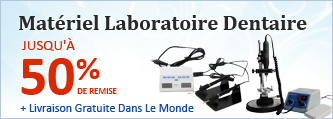- Accueil
- service.zetadental.fr@gmail.com
-
- E-mail : service.zetadental.fr@gmail.com
- Aide Directe
- Favori
- Panier:(0)
- Aide
fr.ishinerdental.com, le plus grand fournisseur en ligne du matériel dentaire pour tous les pays et toutes les régions .
- Votre position:
- Articles
- Santé Dentaire
- Good dental habits is very important
Good dental habits is very important
The best way to protect your child’s teeth is to teach him good dental habits. With the proper coaching he’ll quickly adopt good oral hygiene as a part of his daily routine. However, while he may be an enthusiastic participant, he won’t yet have the control or concentration to brush his teeth all by himself. You’ll need to supervise and help him so that the brush removes all the plaque—the soft, sticky, bacteria- containing deposits that accumulate on the teeth, causing tooth decay. Also, keep an eye out for areas of brown or white spots which might be signs of early decay.
If your child loses his baby teeth by decay or accident too early, his permanent teeth can erupt prematurely and come in crooked because of limited space. According to orthodontists, 30 percent of their cases have their origins in the premature loss of baby teeth.
Brushing and flossing
Your child may need some help brushing until he is between ages 7 and 10. Even if his intentions are good, he may not have the dexterity to clean his teeth well. Ideally, the teeth should be brushed within five minutes to 10 minutes after eating. Also, for long-term dental health, your child needs to care for his gums as well; he should be taught to floss regularly, preferably once a day, in order to help prevent gum disease in adulthood.
A tartar-control toothpaste can help keep plaque from adhering to your child's teeth. Also, fluoride in the toothpaste can strengthen the exposed outer enamel of the youngster's teeth and help prevent cavities. Fluoride also has been added to the water supply in many cities. If your own tap water has less than the recommended levels of this nutrient, your pediatrician may suggest that you add fluoride to your child's diet beginning at age 6 months, often as part of a vitamin supplement. Fluoride treatment should continue until age 16. Ask your doctor or dentist for guidance.
Dental checkups
Make sure your youngster has dental checkups twice a year for cleaning, as well as for X-rays as recommended by your dentist. Parents may choose to utilize a pedodontist, a dentist with special interest and expertise in children's dentistry. Regular preventive appointments will significantly decrease your child's chances of ever having to undergo major dental treatment. Also, contact your dentist whenever your child complains of a toothache. This pain could be a sign of a decayed tooth. Until the dentist can see your child, treat the pain with acetaminophen by mouth.
Preventing cavities
Your dentist may also suggest placing sealants on your child's molars. These thin plastic coatings prevent plaque from accumulating and becoming trapped in the pits and fissures of the teeth. They are appropriate for all rear teeth that have grooves in them, and because they are extremely successful in preventing cavities, they are cost-effective too. Sealants may need to be reapplied during adolescence. With a combination of sealants and fluoride treatment, the incidence of cavities can be reduced by 90 percent.
Diet can also play a role in healthy teeth. In particular, minimize your child's contact with high-sugar and sticky sweets and other carbohydrates. Cut back on snacking on sweets between meals, when these foods are more likely to linger in the mouth without brushing.
By this age you should be helping your child brush her teeth two times a day with a child-sized toothbrush that has soft bristles. There are brushes designed to address the different needs of children at all ages, ensuring that you can select a toothbrush that is appropriate for your child. At this age you can start using a pea- size amount of fluoride toothpaste, which helps prevent cavities. If your child doesn’t like the taste of the toothpaste, try another flavor or use plain water. Also try to teach your child not to swallow it, although at this age they are often still too young to learn to rinse and spit. Swallowing too much fluoride toothpaste can make white or brown spots on your child’s adult teeth.
Préc:Take good care of your children's teeth is never too later
Tous Nos Produits
- Cire
-
- Brûleur à cire (1)
- Réchauffeur de cire (5)
- Couteau à cire (2)
- Équipement médical
-
- oxymètre de pouls (9)
- Moniteur ECG (4)
- Moniteur patient (10)
- Laboratoire
-
- Unité dentaire mobile (4)
- Machine à souder (3)
- MOTEUR D'IMPLANTOLOGIE (2)
- Malaxeur dentaire (3)
- Articulateur dentaire (4)
- Amalgamateur dentaire (6)
- Bec à gaz (2)
- Centrifugateur (1)
- Compresseur & Découpeur (2)
- Perceur dentaire (2)
- loupes dentaires (2)
- Machine à former (2)
- Vibrateur & Paralléliseur (4)
- Instruments rotatifs
-
- Turbine (48)
- Contre Angle (12)
- Instrument à LED (11)
- Moteur d'air (5)
- Pièce à main (5)
- Kit des instruments rotatifs (20)
- Rotor Dentaire (27)
- Fraises dentaires (16)
- D'autres Accessoires (6)
- Lampe à photopolymériser
-
- Lampe Halogène (2)
- Sans fil (31)
- Filaire (6)
- Filaire et sans fil (0)
- Double couleur lumière (0)
- Radiomètre intégré (0)
- Pour fauteuil dentaire (1)
- Guide Optique (2)
- Lunettes de Protection (1)
- D'autres
-
- Brosse à dents électrique (10)
- machine à polir (1)
- tondeuse (2)
- Série Pen (7)
- Service En Ligne
- Paiement
- Contactez-nous
- Entretien & Maintenance
- Guide de lubrification des pièces à main
- L’entretien de votre autoclave
- Autoclave Procedure For Dental High Speed Handpiece
- Infos Site
- Politique de confidentialité sur fr.ishinerdental.com
- Pourquoi choisir fr.ishinerdental.com
- A propos de nous

Service de Newsletter
S'abonner à notre newsletter pour être bien informé des bonnes affaires, des nouveautés et d'autres exclusivities…













